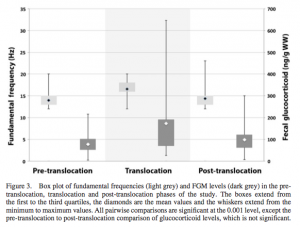A group of researchers situated in South Africa examined the emotional effect of translocating a herd of African elephants. They determined that the frequency of their low-pitch vocalizations was markedly higher, suggesting that higher-frequency vocalizations may be a window into the emotional minds of elephants.
African elephants (Loxodonta africana) are the largest mammals to exist on our planet, and as such, they aren’t easy neighbors to keep! Due to the high value of their ivory tusks, the number of African elephants existing in Africa has dropped from 3 o 4 million in 1960 to only about 500,000 animals today. Despite these alarming numbers, local wildlife management still believe that there are too many elephants for an increasingly human-populated continent to sustain.
One method for managing elephant impact is to translocate them to environments that are able to support them better ecologically. As is the case for many scientists working with animals (especially free-ranging animals), it’s difficult to determine the emotional state of the animals since they can’t openly convey it to us. For this reason, quickly assessable indicators of emotional state can be useful tools in wildlife management to gauge the effects of management procedures.
Elephant vocalizations have been linked to reproductive behaviors, resource utilization, predator alarm and avoidance, coordinating movement, group cohesion, and social interactions. As such a widely used method of communication within a herd, researcher Jozua Jakobus Viljoen and colleagues set out to determine if vocalizations can be used to give us insight into the emotional state of African elephants.
“Rumbles” are very low-pitched vocalizations created by elephants that research has shown to be involved with keeping vocal contact with other elephants and coordinating movements. Rumbles are so low in pitch that humans are actually unable to hear them. If someone were to stand next to an elephant while they were creating a rumble, they would only feel physical vibrations but hear nothing (read more about that here.)
To study the vocalizations, Viljoen and colleagues safely captured a herd of eleven free-ranging elephants in the Kruger National Park in South Africa. The elephants were anesthetized and transported 300 km north of where they were captured. Twenty-three days later, the elephants had made their way back to their original location. During the twenty-three day transit, the researchers took vocal recordings and collected fecal samples. The vocal recordings measured the pitch (or frequency) of the vocalizations, and the fecal samples were used to measure the amount of stress hormones present.
The researchers found that the elephants’ rumbles had a markedly higher pitch during the twenty-three day period compared to both before the translocation and even after returning to their original location. The fecal samples corroborated these findings by indicating an increased amount of stress hormones during the journey back to their origin site (see Figure 3 from their publication below.) Previous research with African elephants has indicated that increased and more variable frequencies in vocalizations are related to higher emotional intensity in mammals. However, it’s important to note that it’s possible that these vocalizations may suggest other high-affect emotional states, such as excitement. Future studies must be done to investigate further into other emotional possibilities.
These results suggest that local elephant management might be able to use vocalizations to measure the outcome and impact of human intervention. This will be useful for elephant conservation as well as a reduction in human-elephant conflicts and a movement towards peaceful coexistence.


